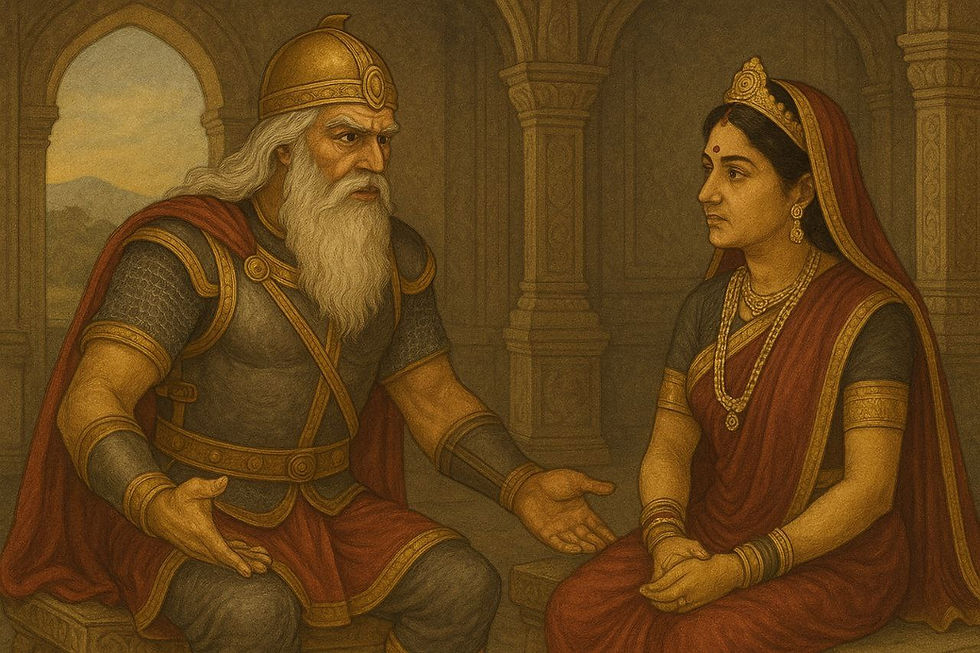Dhritarashtra’s Wedding (Mahabharata Series 12)
- Dheemahi Connect

- Aug 26
- 3 min read
After the birth of the illustrious heirs of the Kuru dynasty, Bhishma, as regent, governed the kingdom with great wisdom and foresight. His rule was firmly rooted in dharma, and the people lived in prosperity and contentment. Bhishma took complete responsibility for the young princes — performing their sacred rites like jatakarma, arranging their education, and ensuring that they were nurtured in discipline and virtue. Under his guardianship, the regions of Kurujangala and Kurukshetra flourished.
The rains came seasonally in abundance, crops grew richly, and the land overflowed with fruits and flowers. There was no trace of thieves or the unrighteous. It seemed as though the age of truth (Krita Yuga) had returned once again.
The princes grew like the waxing moon of the bright fortnight. They gained mastery in both shastra (scriptural knowledge) and shastra (weapons). They excelled in archery, swordsmanship, wrestling, mace-fighting, and horse-riding, as well as in the Vedas, Vedangas, Itihasas, Puranas, and ethics. Their knowledge was profound and certain. Yet, each displayed exceptional skill in one domain: Pandu became supreme in archery, Dhritarashtra in physical strength, and Vidura in statecraft and dharma. The people, in admiration, proclaimed: “Among mothers of valiant sons, the daughters of Kashi are foremost. Among prosperous lands, Kurujangala is the finest. Among the knowers of dharma, Bhishma is unmatched. And among glorious cities, Hastinapura shines supreme.”
Although Dhritarashtra was the eldest, he was blind from birth, and Vidura, being born of a maid, was considered ineligible. Hence, Pandu, the second son, was consecrated as king. He ruled wisely, always guided by the counsel of elders, while Vidura was appointed minister of the Kuru empire.
In time, Bhishma and Vidura began to discuss the future of the dynasty and the necessity of securing a virtuous bride for Dhritarashtra, to ensure the continuation of the Bharata line. Learned Brahmanas were dispatched across the lands in search of such a maiden. They brought word of Gandhari, daughter of King Subala of Gandhara, who had pleased Lord Shiva with her penance and received a boon that she would bear a hundred sons.
Keen to strengthen the dynasty, Bhishma resolved to seek Gandhari’s hand for Dhritarashtra and sent noble envoys to King Subala. At first, the king hesitated to give his daughter to one who was blind, but upon reflecting on the prestige, prosperity, and might of the Kuru lineage, he consented.

When Gandhari learned of her proposed marriage, she bore no anger or sorrow. Accepting her father’s will, she chose to honor her future husband. Out of deep respect for Dhritarashtra, she bound her own eyes with cloth, declaring that she too would never enjoy the sight that her lord was denied. Thus, she embraced blindness as a mark of supreme devotion and chastity.
Adorned with every ornament, Gandhari was brought to Hastinapura by her brother Shakuni, accompanied by festive music and a grand procession. Bhishma, together with the royal household and priests, welcomed her with due honor. In a sacred ceremony amidst the chanting of Vedic mantras, Gandhari was wed to Dhritarashtra. Shakuni, rejoicing, actively took part in the celebrations.
Gandhari’s grace, humility, and unwavering dedication soon won the admiration of all. She was forever engaged in serving her husband and became revered throughout Hastinapura as the very embodiment of pativrata dharma — the ideal of a devoted wife.









Comments